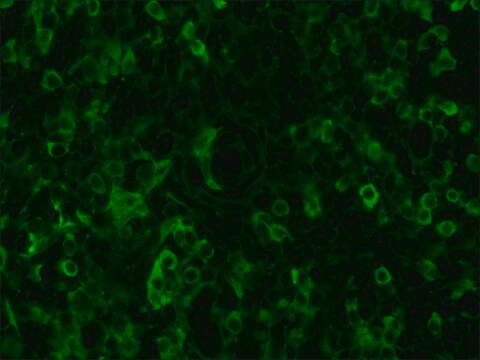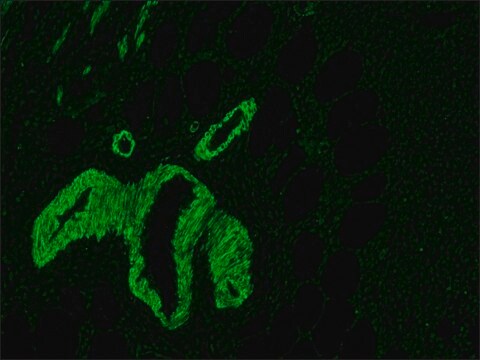추천 제품
생물학적 소스
rabbit
Quality Level
결합
FITC conjugate
항체 형태
affinity isolated antibody
항체 생산 유형
secondary antibodies
클론
polyclonal
양식
buffered aqueous solution
저장 조건
protect from light
기술
direct immunofluorescence: 1:400
immunohistochemistry (formalin-fixed, paraffin-embedded sections): 1:400
저장 온도
−20°C
타겟 번역 후 변형
unmodified
유사한 제품을 찾으십니까? 방문 제품 비교 안내
관련 카테고리
일반 설명
IgG antibodies are smallest and are found in all body fluids and capable of fighting bacterial and viral infection. It is the only type of antibody able to cross the placenta and immunise the foetus. The anti-goat IgG (whole molecule)-FITC antibody is useful in indirect immunofluorescence studies of immunised goat sera infected Trichostrongylus colubriformis (nematode). Antigens can be measured by quantitative immunofluorescence using image analysis, in tissue sections stained with FITC labelled rabbit anti goat IgG. Anti-goat IgG antibody reacts specifically with all goat immunoglobulins.
IgG is a major class of immunoglobulin. Goat IgG has two subclasses- IgG1 and IgG2.
Immunoglobulin G (IgG) is found in blood and has four polypeptide chains. It contains two identical 25 kDa κ or λ light (L) chains and two identical 50 kDa γ heavy (H) chains. The light and heavy chains are interconnected by disulfide bonds. It is the most important type of glycoprotein antibody present in human serum, secreted by the B cells. IgG exists in four isotypes: IgG1, IgG2, IgG3, and IgG4. IgG has the longest serum half-life compared to other immunoglobulins.
면역원
IgG purified from Goat
애플리케이션
Anti-Goat IgG (whole molecule)−FITC antibody has been used:
- in double labeling for laminin and α-fetoprotein (AFP) at a dilution of 1:400
- in immunohistochemistry at a dilution of 1:50
- in immunocytochemistry
- in immunochemical jagged-1 analyses
- in immunofluorescence at a dilution of 1:200
Anti-goat IgG antibody can be used in antisera localization for neurofilament antigens obtained in rat peripheral nerve and can be done in tissues of rat and human peripheral and central nervous system by the aid of indirect immunofluorescence.
생화학적/생리학적 작용
Immunoglobulin G (IgG) participates in hypersensitivity type II and type III.
Immunoglobulin G (IgG) stimulates the classical pathway of the complement system. Maternal IgG is transferred to the fetus through the placenta. This is vital for the immune defense of the neonate against infections. IgG regulates antibody-dependent cell-mediated cytotoxicity (ADCC) and might be associated with allergy. It nullifies virus particles and toxins. Digestion of IgG by papain produces fragment antigen-binding (Fab). Pepsin digestion of IgG generates crystallizable (fc) fragment and a single dimeric F(ab)2. IgG levels in severe acute respiratory syndrome coronavirus (SARS-CoV)-2 infected patients may be used as a possible tool to assess the severity and prognosis of coronavirus disease 2019 (COVID-19).
물리적 형태
Solution in 0.01 M phosphate buffered saline, pH 7.4, containing 15 mM sodium azide.
저장 및 안정성
For continuous use, store at 2-8 °C for up to one month. For extended storage, the solution may be frozen in working aliquots. Repeated freezing and thawing is not recommended. Storage in "frost-free" freezers not recommended. If slight turbidity occurs upon prolonged storage, clarify the solution by centrifugation before use.
면책조항
Unless otherwise stated in our catalog or other company documentation accompanying the product(s), our products are intended for research use only and are not to be used for any other purpose, which includes but is not limited to, unauthorized commercial uses, in vitro diagnostic uses, ex vivo or in vivo therapeutic uses or any type of consumption or application to humans or animals.
적합한 제품을 찾을 수 없으신가요?
당사의 제품 선택기 도구.을(를) 시도해 보세요.
Storage Class Code
10 - Combustible liquids
WGK
nwg
개인 보호 장비
Eyeshields, Gloves, multi-purpose combination respirator cartridge (US)
가장 최신 버전 중 하나를 선택하세요:
시험 성적서(COA)
Lot/Batch Number
이미 열람한 고객
Ji-Young Bae et al.
Nutrition research and practice, 1(4), 279-284 (2007-01-01)
Solar ultraviolet (UV) irradiation leads to distinct changes in the skin connective tissues by degradation of collagen, which is a major structural component in the extracellular matrix. UV irradiation induces the production of matrix metalloproteinases (MMP) capable of attacking native
Migration, matrix production and lamellar bone formation of human osteoblast-like cells in porous titanium implants
Frosch KH, et al.
Cells Tissues Organs, 170(4), 214-227 (2002)
Origin and structural evolution of the early proliferating oval cells in rat liver
Paku S, et al.
The American Journal of Pathology, 158(4), 1313-1323 (2001)
The effect of topical amiloride eye drops on tear quantity in rabbits
Hara S, et al.
Molecular Vision, 16(4), 2279-2279 (2010)
W W Schlaepfer et al.
The Journal of cell biology, 74(1), 241-250 (1977-07-01)
Localization of antisera to neurofilament antigens derived from rat peripheral nerve was carried out in tissues of rat and human peripheral and central nervous systems by indirect immunofluorescence. Unfixed and chloroform-methanol-fixed frozen sections of tissues were incubated in purified IgG
자사의 과학자팀은 생명 과학, 재료 과학, 화학 합성, 크로마토그래피, 분석 및 기타 많은 영역을 포함한 모든 과학 분야에 경험이 있습니다..
고객지원팀으로 연락바랍니다.











